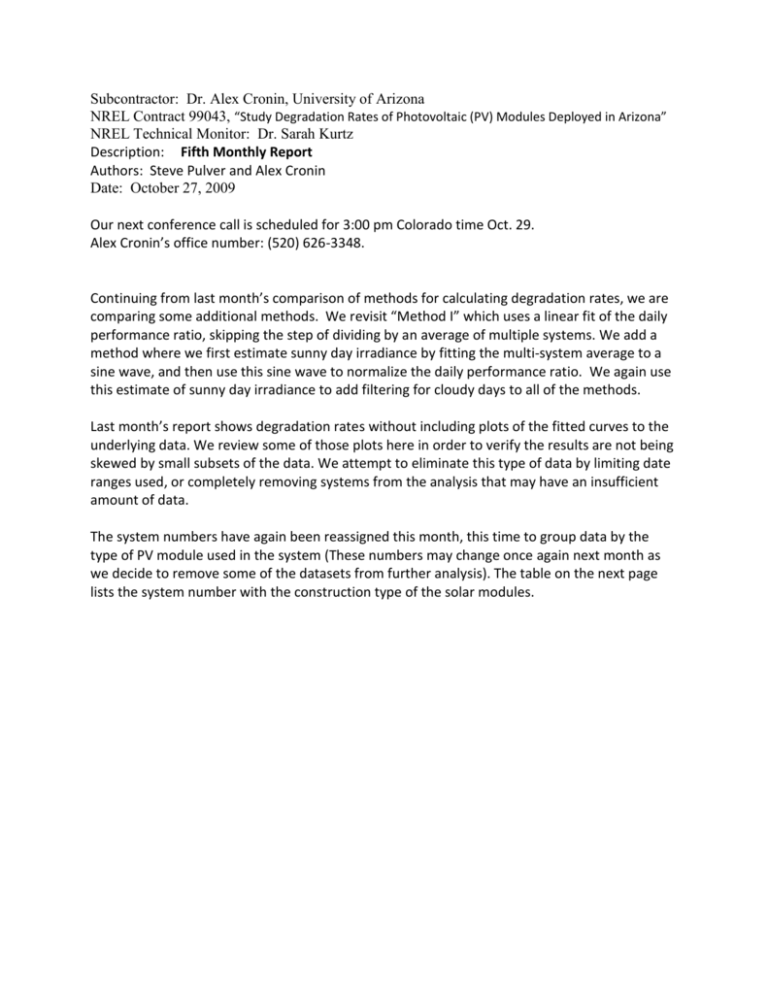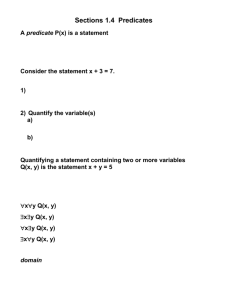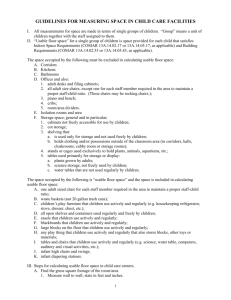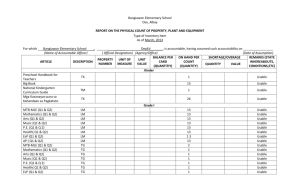Monthly Report 5 on NREL 99034
advertisement

Subcontractor: Dr. Alex Cronin, University of Arizona NREL Contract 99043, “Study Degradation Rates of Photovoltaic (PV) Modules Deployed in Arizona” NREL Technical Monitor: Dr. Sarah Kurtz Description: Fifth Monthly Report Authors: Steve Pulver and Alex Cronin Date: October 27, 2009 Our next conference call is scheduled for 3:00 pm Colorado time Oct. 29. Alex Cronin’s office number: (520) 626-3348. Continuing from last month’s comparison of methods for calculating degradation rates, we are comparing some additional methods. We revisit “Method I” which uses a linear fit of the daily performance ratio, skipping the step of dividing by an average of multiple systems. We add a method where we first estimate sunny day irradiance by fitting the multi-system average to a sine wave, and then use this sine wave to normalize the daily performance ratio. We again use this estimate of sunny day irradiance to add filtering for cloudy days to all of the methods. Last month’s report shows degradation rates without including plots of the fitted curves to the underlying data. We review some of those plots here in order to verify the results are not being skewed by small subsets of the data. We attempt to eliminate this type of data by limiting date ranges used, or completely removing systems from the analysis that may have an insufficient amount of data. The system numbers have again been reassigned this month, this time to group data by the type of PV module used in the system (These numbers may change once again next month as we decide to remove some of the datasets from further analysis). The table on the next page lists the system number with the construction type of the solar modules. Material Make (Model) a-Si System No. 1 Sticker Rating 60*50 W Relative Annual Degradation Rate + 1.7 % CIS/CIGS 2 32*45 W - 1.1 % 3 Global Solar GSE (GG112,13309) Shell Solar (ST40) 38*40 W - 1.4 % HIT (Si) 4 5 Sanyo (HIP-G751BA2) Sanyo (HIP-J54 BA2) 8*167 W 8*180 W + 0.4 % + 1.8 % MJ-Si 6 7 8 9 BP Solar (MST50MVHS) BP Solar (MST50 MVHS) BP Solar (MST50 MVHS) UniSolar (US-64) 30*50 W 150*50 W 30*50 W 24*64 W - 2.9 % not enough data 0.0 % (noisy) + 2.4 % (noisy) px-Si 10 11 12 13 BP Solar (BP 3150U) BP Solar (SX140S) Kyocera (KC150G-A) Schott ASE (ASE-300DGF/17) Schott ASE (ASE-300DGF/50) Schott ASE (ASE-300DGF/50) Schott ASE (ASE-300DGF/50) Sharp (NE-Q5E2U) 10*150 W 9*150 W 4*315 W + 0.7 % + 1.6 % + 2.1 % not enough data 4*300 W + 0.5 % (noisy) 72*315 W - 0.2 % 72*315 W + 0.4 % 18*165 W not enough data AstroPower (API-165MCB) 9*165 W + 0.9 % 14 15 16 17 x-Si 18 Solarex (MST-43MV) Systems not located at the TEP Test Yard: System No. 19 20 21 22 Distance from TEP test yard 10.5 mi 6.5 mi 6.5 mi 2 mi Make Sticker (Model) Rating 21.6 kW 108 kW 108 kW 1.2 kW Relative Degradation Rate - 0.6 % - 1.5 % - 1.4 % + 0.6 % Degradation rates for 22 systems using 6 methods. The methods named in the key are discussed in this report. Since the average decays at 1.1% per year, it is expected that normalizing by the average will cause increased rates by this amount. AVG kwh/kw vs date. The average daily (kwh/kwrated) shows 2297 sunny days (black squares) 2912 days total (red and black points). An empirical function (blue curve) helps to identify sunny days. The empirical function used here to mimic sunny days is: sunnyempirical = 4.85 + 0.6*sin(day*0.03442 - 1.508), where day is day since jan1 2004. The black points are within 1h of sunnyempirical. Raw data systems 1-8 Raw data systems 9-16 Raw data systems 17-22 Sunny days only systems 1-8 Based on our identified start and stop dates, most systems have a 3 to 5 year long duration which we plan to study. Systems with short durations will be excluded from the final analysis. Next we show all the individual data sets with just the sunny days. Sunny days only systems 9-17 Sunny days only systems 18-22 Sunny days only, divide by AVG, systems 1-8 Sunny days only, divide by AVG, systems 9-17 Sunny days only, divided by AVG, systems 18-22 normalized to EMPIRICAL normalized to Empirical sys 9-17 normalized to Empirical sys 18-22 In the following, we try to justify eliminating some date ranges by estimating average values for each segment of 365 data points, doing a line fit to the underlying points, and removing segments that are more than 4% from the linear fit. Also, we remove any datasets that don’t include at least 3 years of usable data. 2.0 1.5 1.0 0.5 1/1/2002 1/1/2004 1/1/2006 1/1/2008 1/1/2006 1/1/2008 System1 System 1 has 3 years of usable data. 2.0 1.5 1.0 0.5 1/1/2002 1/1/2004 System2 System 2, final year of data falls outside of 4% range. 2.0 1.5 1.0 0.5 1/1/2002 1/1/2004 1/1/2006 1/1/2008 1/1/2006 1/1/2008 System3 System 3 has at least 3 years of usable data. 2.0 1.5 1.0 0.5 1/1/2002 1/1/2004 System4 System 4 has at least 3 years of usable data. 2.0 1.5 1.0 0.5 1/1/2002 1/1/2004 1/1/2006 1/1/2008 1/1/2006 1/1/2008 System5 System 5 has at least 3 years of usable data. 2.0 1.5 1.0 0.5 1/1/2002 1/1/2004 System6 System 6 has at least 3 years of usable data, with 1 year falling outside of the 4 % range, may want to remove data prior to 2002. 2.0 1.5 1.0 0.5 1/1/2002 1/1/2004 1/1/2006 1/1/2008 1/1/2006 1/1/2008 System7 System 7 has at least 3 years of usable data. 2.0 1.5 1.0 0.5 1/1/2002 1/1/2004 System8 System 8 has at least 3 years of usable data, may want to remove data after 2008. 2.0 1.5 1.0 0.5 1/1/2002 1/1/2004 1/1/2006 1/1/2008 1/1/2006 1/1/2008 System9 System 9 has at least 3 years of usable data. 2.0 1.5 1.0 0.5 1/1/2002 1/1/2004 System10 System 10 has at least 3 years of usable data. 2.0 1.5 1.0 0.5 1/1/2002 1/1/2004 1/1/2006 1/1/2008 1/1/2006 1/1/2008 System11 System 11, final year of data falls outside of 4% range. 2.0 1.5 1.0 0.5 1/1/2002 1/1/2004 System12 System 12 has at least 3 years of usable data. 2.0 1.5 1.0 0.5 1/1/2002 1/1/2004 1/1/2006 1/1/2008 1/1/2006 1/1/2008 System13 System 13 has at least 3 years of usable data. 2.0 1.5 1.0 0.5 1/1/2002 1/1/2004 System14 System 14, appears that data prior to 2004 and after 2007 would need to be discarded in order to fit within a 4% range. 2.0 1.5 1.0 0.5 1/1/2002 1/1/2004 1/1/2006 1/1/2008 1/1/2006 1/1/2008 System15 System 15 has at least 3 years of usable data. 2.0 1.5 1.0 0.5 1/1/2002 1/1/2004 System16 System 16 has at least 3 years of usable data. One year falls outside of the 4 % range. 2.0 1.5 1.0 0.5 1/1/2002 1/1/2004 1/1/2006 1/1/2008 1/1/2006 1/1/2008 System17 System 17 has less than 3 years of usable data. 2.0 1.5 1.0 0.5 1/1/2002 1/1/2004 System18 System 18 has less than 3 years of usable data 2.0 1.5 1.0 0.5 1/1/2002 1/1/2004 1/1/2006 1/1/2008 System19 System 19, removing data after 2008 would allow a fit within a 4% range. 2.0 1.5 1.0 0.5 1/1/2002 1/1/2004 1/1/2006 1/1/2008 System20 System 20, appears that data prior to 2003 and after 2006 would need to be discarded in order to fit within a 4% range. 2.0 1.5 1.0 0.5 1/1/2002 1/1/2004 1/1/2006 1/1/2008 System21 System 21, appears that data prior to 2003 and after 2007 would need to be discarded in order to fit within a 4% range. 2.0 1.5 1.0 0.5 1/1/2002 1/1/2004 1/1/2006 1/1/2008 System22 System 22, appears that data prior to 2003 and after 2008 would need to be discarded in order to fit within a 4% range. For the following calculations, the data from systems 14, 17, 18, 20, 21, and 22 were not included; and the final year of data was removed from systems 2, 11, and 19. Using a cutoff percentage larger than 4% at systems not located at the TEP Test Yard may be desirable. 14 12 10 8 6 4 2 1/1/2002 1/1/2004 1/1/2006 1/1/2008 1/1/2006 1/1/2008 dat 6 5 4 3 2 1 0 1/1/2002 1/1/2004 dat Number of systems on and daily average after the above systems were removed or edited. The above plots presented again, using the edited data and the new calculated average. 2.0 1.5 1.0 0.5 1/1/2002 1/1/2004 1/1/2006 1/1/2008 1/1/2006 1/1/2008 System1 2.0 1.5 1.0 0.5 1/1/2002 1/1/2004 System2 2.0 1.5 1.0 0.5 1/1/2002 1/1/2004 1/1/2006 1/1/2008 1/1/2006 1/1/2008 System3 2.0 1.5 1.0 0.5 1/1/2002 1/1/2004 System4 2.0 1.5 1.0 0.5 1/1/2002 1/1/2004 1/1/2006 1/1/2008 1/1/2006 1/1/2008 System5 2.0 1.5 1.0 0.5 1/1/2002 1/1/2004 System6 2.0 1.5 1.0 0.5 1/1/2002 1/1/2004 1/1/2006 1/1/2008 1/1/2006 1/1/2008 System7 2.0 1.5 1.0 0.5 1/1/2002 1/1/2004 System8 2.0 1.5 1.0 0.5 1/1/2002 1/1/2004 1/1/2006 1/1/2008 1/1/2006 1/1/2008 System9 2.0 1.5 1.0 0.5 1/1/2002 1/1/2004 System10 2.0 1.5 1.0 0.5 1/1/2002 1/1/2004 1/1/2006 1/1/2008 1/1/2006 1/1/2008 System11 2.0 1.5 1.0 0.5 1/1/2002 1/1/2004 System12 2.0 1.5 1.0 0.5 1/1/2002 1/1/2004 1/1/2006 1/1/2008 1/1/2006 1/1/2008 System13 2.0 1.5 1.0 0.5 1/1/2002 1/1/2004 System15 2.0 1.5 1.0 0.5 1/1/2002 1/1/2004 1/1/2006 1/1/2008 1/1/2006 1/1/2008 System16 2.0 1.5 1.0 0.5 1/1/2002 1/1/2004 System19 Fitting this data to w[2]+w[1]*t+w[0]*cos(2*pi*t/(365*24*60*60)+2.46) 1.6 1.4 1.2 1.0 0.8 0.6 0.4 1/1/2002 1/1/2004 1/1/2006 1/1/2008 1/1/2006 1/1/2008 System1 1.6 1.4 1.2 1.0 0.8 0.6 0.4 1/1/2002 1/1/2004 System2 1.6 1.4 1.2 1.0 0.8 0.6 0.4 1/1/2002 1/1/2004 1/1/2006 1/1/2008 1/1/2006 1/1/2008 System3 1.6 1.4 1.2 1.0 0.8 0.6 0.4 1/1/2002 1/1/2004 System4 1.6 1.4 1.2 1.0 0.8 0.6 0.4 1/1/2002 1/1/2004 1/1/2006 1/1/2008 1/1/2006 1/1/2008 System5 1.6 1.4 1.2 1.0 0.8 0.6 0.4 1/1/2002 1/1/2004 System6 1.6 1.4 1.2 1.0 0.8 0.6 0.4 1/1/2002 1/1/2004 1/1/2006 1/1/2008 1/1/2006 1/1/2008 System7 1.6 1.4 1.2 1.0 0.8 0.6 0.4 1/1/2002 1/1/2004 System8 1.6 1.4 1.2 1.0 0.8 0.6 0.4 1/1/2002 1/1/2004 1/1/2006 1/1/2008 1/1/2006 1/1/2008 System9 1.6 1.4 1.2 1.0 0.8 0.6 0.4 1/1/2002 1/1/2004 System10 1.6 1.4 1.2 1.0 0.8 0.6 0.4 1/1/2002 1/1/2004 1/1/2006 1/1/2008 1/1/2006 1/1/2008 System11 1.6 1.4 1.2 1.0 0.8 0.6 0.4 1/1/2002 1/1/2004 System12 1.6 1.4 1.2 1.0 0.8 0.6 0.4 1/1/2002 1/1/2004 1/1/2006 1/1/2008 1/1/2006 1/1/2008 System13 1.6 1.4 1.2 1.0 0.8 0.6 0.4 1/1/2002 1/1/2004 System15 1.6 1.4 1.2 1.0 0.8 0.6 0.4 1/1/2002 1/1/2004 1/1/2006 1/1/2008 1/1/2006 1/1/2008 System16 1.6 1.4 1.2 1.0 0.8 0.6 0.4 1/1/2002 1/1/2004 System19 The resulting degradation rates using a line fit, and a line + cosine fit. Systems 6, 8, and 9 were then calculated again using reduced range of dates, this time determine by visual appearance System 9: July 8, 2005-May 16, 2009 System 6: Nov 4, 2003-May 16,2009 System 8: May 22, 2004-Jan 16, 2008 1.2 1.0 0.8 0.6 0.4 0.2 1/1/2002 1/1/2004 1/1/2006 System8 1/1/2008 1.4 1.2 1.0 0.8 0.6 0.4 0.2 1/1/2002 1/1/2004 1/1/2006 1/1/2008 1/1/2006 1/1/2008 System9 1.6 1.4 1.2 1.0 0.8 0.6 0.4 0.2 1/1/2002 1/1/2004 System6 rate of change per year 0.05 0.00 sunny ; norm to avg; start-stop sunny ; norm to avg; start-Nyrs all weather ; norm to avg sunny only ; norm to empirical all weather; norm to empirical linecosinefit linefit -0.05 -0.10 0 5 10 system number 15 20









